-
Paper Information
- Paper Submission
-
Journal Information
- About This Journal
- Editorial Board
- Current Issue
- Archive
- Author Guidelines
- Contact Us
International Journal of Theoretical and Mathematical Physics
p-ISSN: 2167-6844 e-ISSN: 2167-6852
2019; 9(5): 136-152
doi:10.5923/j.ijtmp.20190905.03

Periodic Solutions of the Dirac-Lorentz Equation
Vasil Angelov
Department of of Mathematics, University of Mining and Geology “St. I. Rilski”, Sofia, Bulgaria
Correspondence to: Vasil Angelov, Department of of Mathematics, University of Mining and Geology “St. I. Rilski”, Sofia, Bulgaria.
| Email: |  |
Copyright © 2019 The Author(s). Published by Scientific & Academic Publishing.
This work is licensed under the Creative Commons Attribution International License (CC BY).
http://creativecommons.org/licenses/by/4.0/

In a previous paper we have derived a new form of the radiation term without changing the Dirac physical assumptions. We have showed also that the fourth Dirac equation is a consequence of the first three ones, that implies the Dirac system is not overdetermined – three equations for three unknown functions. Here we replace the Dirac local expansions with nonlocal formulation of the problem. So we have obtained a system of first order neutral differential equations with respect to the unknown velocities containing both retarded and advanced arguments. Since the accelerator theory relies on the Dirac-Lorentz equation the obtained periodic solutions can be applied directly to the study of betatron equation.
Keywords: Dirac-Lorentz equation, Fixed point method, Periodic operator, Periodic solution
Cite this paper: Vasil Angelov, Periodic Solutions of the Dirac-Lorentz Equation, International Journal of Theoretical and Mathematical Physics, Vol. 9 No. 5, 2019, pp. 136-152. doi: 10.5923/j.ijtmp.20190905.03.
Article Outline
1. Introduction
- In a previous paper [1] we have derived a general form of the Dirac radiation term [2], [3] based on his original physical assumptions (cf. [3]). In the relativistic case the usually accepted radiation term leads to the well-known Dirac (or Lorentz-Dirac) equations [3]
 | (1) |
 are the coordinates of the electron, e is its charge, m – its rest mass, c – the speed of the light, the dot is a differentiation with respect to the arc length, i.e.
are the coordinates of the electron, e is its charge, m – its rest mass, c – the speed of the light, the dot is a differentiation with respect to the arc length, i.e. , and the Einstein summation convention is valid. The second term in (1) is the Abraham four-vector of radiation reaction derived also by Dirac [3]. Here we replace the radiation term in (1) by the one obtained in [1]. We consider just first three equations because in [1] is proved that the fourth one is a consequence of the rest ones. We have applied a similar form of the radiation terms to two-body problem of classical electrodynamics [4]- [6]. Many results concerning radiation terms are contained in [7]-[32]. They are based on various methods. Here we use the fixed point method from [33]. The derivation of the new form of the radiation term is based on the relativistic form of the retarded and advanced Lienard-Wiechert potentials [8]-[10], [34], [35]. We stand on the theory of differential equations of neutral type with both retarded and advanced arguments caused by the finite propagation of the interaction – the basic assumption of the Einstein relativistic theory. So Dirac equations become second order neutral equations. The main goal of the present paper is to prove an existence-uniqueness of a periodic solution for Dirac equations. We use an operator formulation of the periodic problem from [36]. In view of [37]-[39] we are able to apply the results obtained to betatron radiation.The paper consists of six sections. In Section 2 we derive the Dirac equations using retarded and advanced potentials. In Section 3 we derive a new form of the radiation term. In Section 4 we formulate a periodic problem and give some preliminary assertions. In Section 5 we give an operator formulation of the periodic problem and by a suitable fixed point theorem prove an existence-uniqueness of periodic solution for Dirac equations. Section 6 contains a conclusion remark.
, and the Einstein summation convention is valid. The second term in (1) is the Abraham four-vector of radiation reaction derived also by Dirac [3]. Here we replace the radiation term in (1) by the one obtained in [1]. We consider just first three equations because in [1] is proved that the fourth one is a consequence of the rest ones. We have applied a similar form of the radiation terms to two-body problem of classical electrodynamics [4]- [6]. Many results concerning radiation terms are contained in [7]-[32]. They are based on various methods. Here we use the fixed point method from [33]. The derivation of the new form of the radiation term is based on the relativistic form of the retarded and advanced Lienard-Wiechert potentials [8]-[10], [34], [35]. We stand on the theory of differential equations of neutral type with both retarded and advanced arguments caused by the finite propagation of the interaction – the basic assumption of the Einstein relativistic theory. So Dirac equations become second order neutral equations. The main goal of the present paper is to prove an existence-uniqueness of a periodic solution for Dirac equations. We use an operator formulation of the periodic problem from [36]. In view of [37]-[39] we are able to apply the results obtained to betatron radiation.The paper consists of six sections. In Section 2 we derive the Dirac equations using retarded and advanced potentials. In Section 3 we derive a new form of the radiation term. In Section 4 we formulate a periodic problem and give some preliminary assertions. In Section 5 we give an operator formulation of the periodic problem and by a suitable fixed point theorem prove an existence-uniqueness of periodic solution for Dirac equations. Section 6 contains a conclusion remark.2. Derivation of Dirac Equations Using Retarded and Advanced Potentials
- First we recall some basic notions and denotations following the Synge formalism [35] (cf. also [34]). Consider a charge e describing any curve L in the space-time. Let
 be any event. The unit tangent vector to L at A is
be any event. The unit tangent vector to L at A is where
where  and
and  is the scalar product in 4-dimensional Minkowski space, while
is the scalar product in 4-dimensional Minkowski space, while  is the scalar product in 3-dimensional Euclidian subspace.Let
is the scalar product in 3-dimensional Euclidian subspace.Let  be the intersection of L with the null-cone drawn into the past from A, and let
be the intersection of L with the null-cone drawn into the past from A, and let  be the intersection of L with the null-cone drawn into the future from A where
be the intersection of L with the null-cone drawn into the future from A where  and
and  Let
Let  be the unit tangent vector to the world line L at
be the unit tangent vector to the world line L at  , where
, where  and let
and let  be the unit tangent vector to L at
be the unit tangent vector to L at  , where
, where  Let
Let  be the retarded isotropic vector
be the retarded isotropic vector  and let
and let be the advanced isotropic vector
be the advanced isotropic vector  In accordance with the Dirac assumptions [3] the radiation term is defined as a half of the difference between both retarded and advanced potentials, that is,
In accordance with the Dirac assumptions [3] the radiation term is defined as a half of the difference between both retarded and advanced potentials, that is,  where
where  are the Lienard-Wiechert retarded and advanced potentials (cf. [8]-[10], [34], [35]).So that the Dirac physical assumptions lead to the following form of the equations of motion:
are the Lienard-Wiechert retarded and advanced potentials (cf. [8]-[10], [34], [35]).So that the Dirac physical assumptions lead to the following form of the equations of motion:  or
or Further on we assume (cf. [1]) that(AR):
Further on we assume (cf. [1]) that(AR):  In fact, postulating (AR) we extend the relation between the relativistic and Newton absolute time. Since
In fact, postulating (AR) we extend the relation between the relativistic and Newton absolute time. Since  and
and  lie on the trajectory L we obtain
lie on the trajectory L we obtain
 and
and where
where 
 where
where  Therefore the isotropic vectors become
Therefore the isotropic vectors become and
and In general case the functions
In general case the functions  can be obtained as solutions of the functional equations
can be obtained as solutions of the functional equations or
or  In what follows we briefly repeat the calculations from [1]:
In what follows we briefly repeat the calculations from [1]: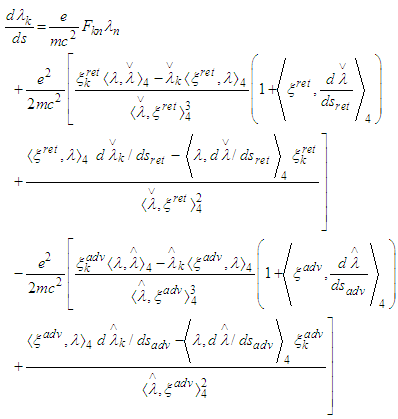 | (2) |
 Here
Here  and
and  is the electric field intensity vector, and
is the electric field intensity vector, and  − the magnetic field intensity vector.
− the magnetic field intensity vector.3. Derivation of the Radiation Term
- Following [1] we have to find the relations between the derivatives at past, present and future instants. The above system (2) can be split into “space-like” and “time-like” parts:
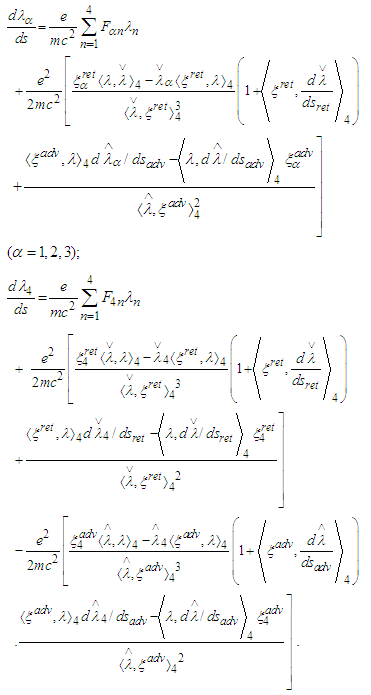 Differentiating the relation
Differentiating the relation  with respect to
with respect to  , considering
, considering  we obtain
we obtain In a similar way differentiating
In a similar way differentiating  with respect to
with respect to  (considering
(considering  ) we obtain
) we obtain We derive the radiation term under the Dirac assumptions (D):
We derive the radiation term under the Dirac assumptions (D): where
where  is a small parameter.The Dirac assumption is justified by the fact that, for example, the electron radiation time is
is a small parameter.The Dirac assumption is justified by the fact that, for example, the electron radiation time is  sec.Applying the Taylor theorem under assumption (D) we get
sec.Applying the Taylor theorem under assumption (D) we get  It follows
It follows  . Consequently
. Consequently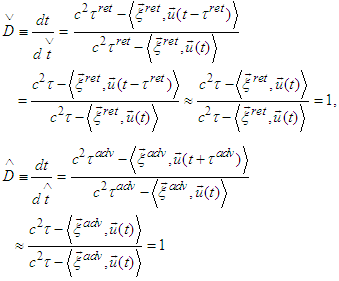 and then
and then Therefore the above system becomes
Therefore the above system becomes | (3) |
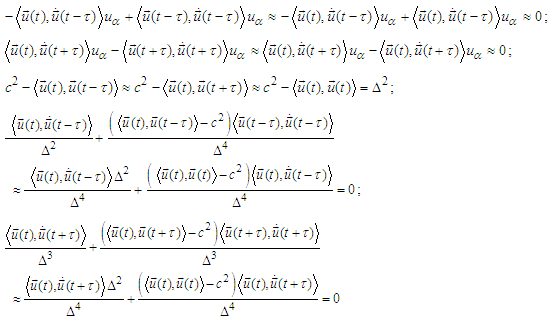 we obtain
we obtain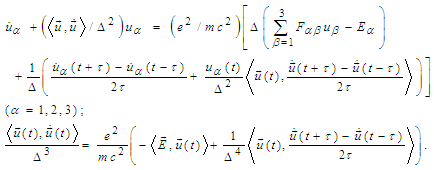 Denoting by
Denoting by we write the system
we write the system  in the form
in the form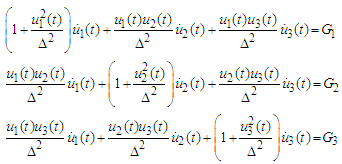 | (4) |
 . Assumption (C):
. Assumption (C):  for some constant
for some constant  .Therefore
.Therefore  and the determinant of the above system is obviously different from zero
and the determinant of the above system is obviously different from zero  Consequently, the uni- que solution of (4) is
Consequently, the uni- que solution of (4) is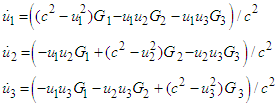 | (5) |
 we get
we get | (6) |
4. An Operator Formulation of the Periodic Problem and Preliminary Assertions
- We formulate the main periodic problem: to find a
 - periodic solution
- periodic solution  of the system (6) on the interval
of the system (6) on the interval  with initial conditions
with initial conditions  ,
,  and
and 
 where
where  are prescribed
are prescribed  -periodic initial functions.Let
-periodic initial functions.Let  be the set of all
be the set of all  -periodic functions from
-periodic functions from  whose derivatives of arbitrary order belong to
whose derivatives of arbitrary order belong to  . The functions from
. The functions from  are considered as all infinite differentiable functions on
are considered as all infinite differentiable functions on  having continuous extensions on
having continuous extensions on  . Introduce the function sets:
. Introduce the function sets: where
where  ,
, Remark 1. It is easy to verify that substituting
Remark 1. It is easy to verify that substituting  we get
we get  We define the following family of pseudo-metrics
We define the following family of pseudo-metrics Since for
Since for we have
we have  It follows
It follows  and then we put
and then we put Further on we set
Further on we set Lemma 1. If
Lemma 1. If  then
then is
is  -periodic function.Proof: Let us set
-periodic function.Proof: Let us set  and then we obtain
and then we obtain  . Therefore
. Therefore Lemma 1 is thus proved.Define the operator
Lemma 1 is thus proved.Define the operator
 where by assumption
where by assumption  and
and  are the right-hand sides of (6).Lemma 2. ([36]) For every
are the right-hand sides of (6).Lemma 2. ([36]) For every  it follows
it follows Assumptions (H-E): The functions
Assumptions (H-E): The functions 
 are
are  -periodic and smooth in t and
-periodic and smooth in t and 
 Lemma 3. (Main Lemma) The periodic problem (6) has a solution
Lemma 3. (Main Lemma) The periodic problem (6) has a solution  iff the operator B has a fixed point belonging to
iff the operator B has a fixed point belonging to  , provided
, provided where
where  are positive constants.Proof: Let
are positive constants.Proof: Let  be a
be a  -periodic solution of the system
-periodic solution of the system  . Then after integration in view of
. Then after integration in view of  (that is
(that is  and
and  ) we obtain
) we obtain | (7) |
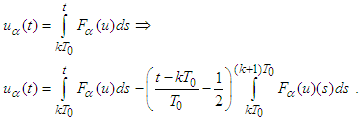 Besides in view of (7) we have
Besides in view of (7) we have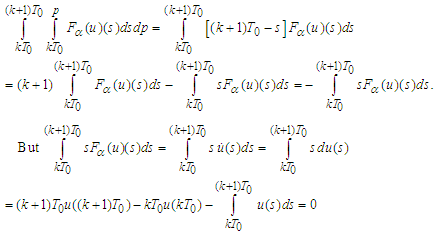 that implies
that implies  Consequently,
Consequently,  can be written in the form
can be written in the form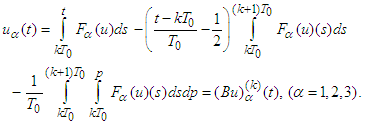 The last equalities mean that B has a fixed point in
The last equalities mean that B has a fixed point in  .Conversely, let
.Conversely, let  be a fixed point of B. Then the last equalities are satisfied and substituting
be a fixed point of B. Then the last equalities are satisfied and substituting  we get
we get that implies
that implies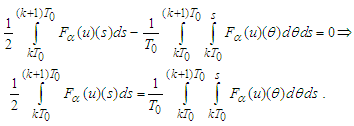 We show that
We show that  . Indeed, Let us suppose that
. Indeed, Let us suppose that  . Then we obtain
. Then we obtain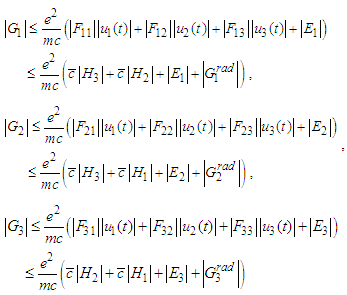 which implies
which implies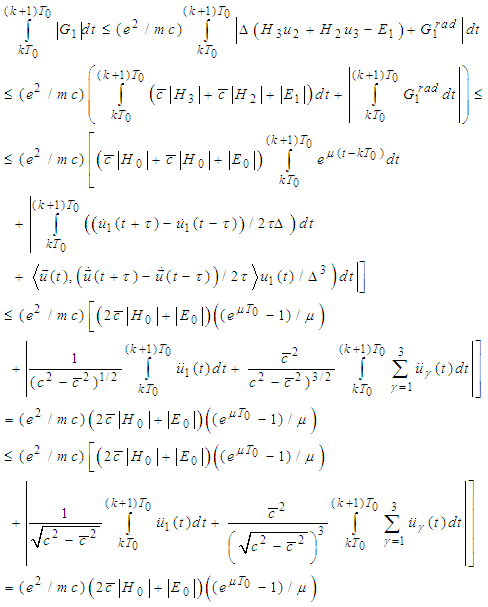 since
since  In a similar way we get
In a similar way we get 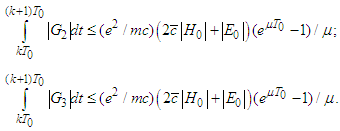 Consequently
Consequently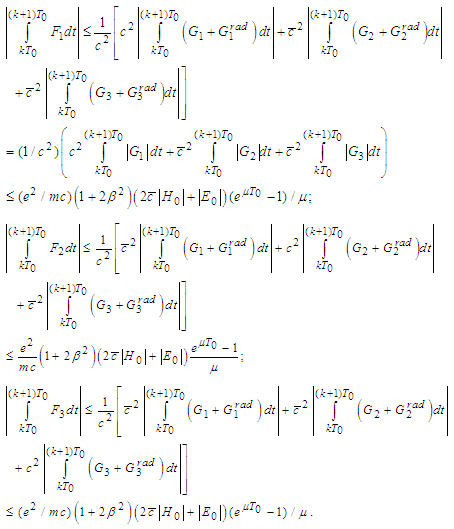 Since
Since  = const for sufficiently large
= const for sufficiently large  and small
and small  we can obtain
we can obtain  . Therefore
. Therefore becomes
becomes  Differentiating the last equality we obtain the required assertion.Lemma 3 is thus proved.
Differentiating the last equality we obtain the required assertion.Lemma 3 is thus proved.5. Existence-Uniqueness of the Periodic Problem
- Theorem 1 (Main result) Let the following conditions be fulfilled:1. The initial functions
 are defined on
are defined on  and are such that their translations to the right on
and are such that their translations to the right on  coincide with some functions from
coincide with some functions from  and
and  , where
, where  for some positive integer m.2. The components of intensity electric and magnetic vectors satisfy the assumptions (H-E); 3. The following inequalities are satisfied:
for some positive integer m.2. The components of intensity electric and magnetic vectors satisfy the assumptions (H-E); 3. The following inequalities are satisfied: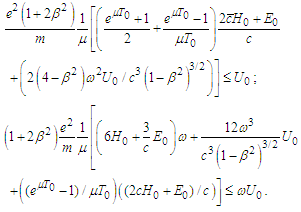 Then there is a unique
Then there is a unique  -periodic solution of (6)
-periodic solution of (6)  .Proof: In view of the Main Lemma 3 we have to prove that the operator B possesses a unique fixed point. This fixed point is a
.Proof: In view of the Main Lemma 3 we have to prove that the operator B possesses a unique fixed point. This fixed point is a  -periodic solution of (6). The set
-periodic solution of (6). The set  turns out into a uniform space with a saturated family of pseudo-metrics for
turns out into a uniform space with a saturated family of pseudo-metrics for :
: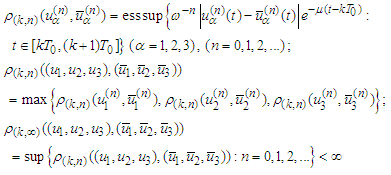 since
since  where the index set is
where the index set is  Define the operator
Define the operator  by the formulas
by the formulas
 , where
, where  are the right-hand sides of (6).We show that B maps
are the right-hand sides of (6).We show that B maps  into itself. Since
into itself. Since  we have shown in the Main Lemma 3 that
we have shown in the Main Lemma 3 that  Therefore
Therefore  First we check the following equality
First we check the following equality Further on for
Further on for  we obtain
we obtain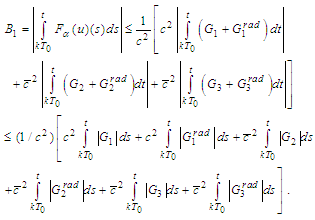 We have
We have 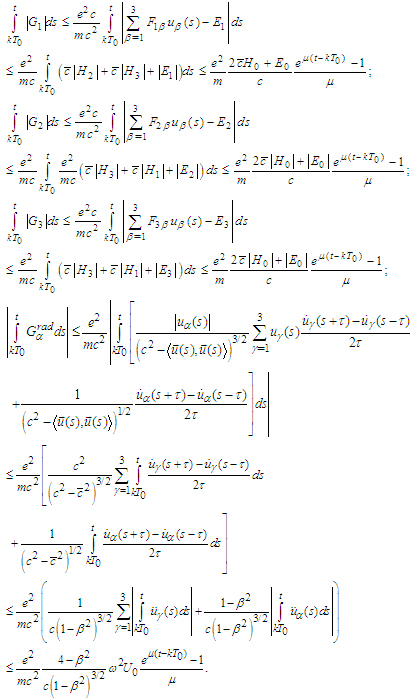 Therefore
Therefore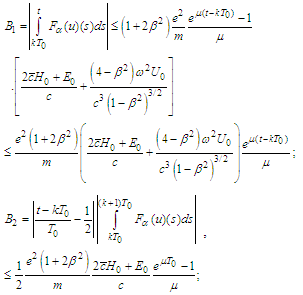
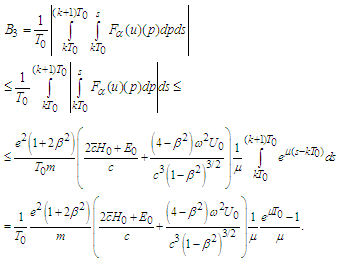 Finally we reach the estimate
Finally we reach the estimate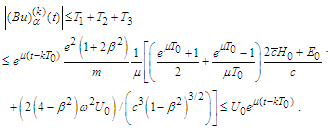 Let us estimate the derivatives
Let us estimate the derivatives Then in view of
Then in view of  we obtain
we obtain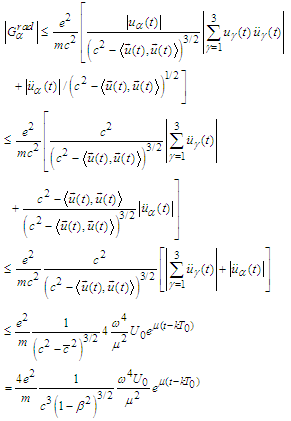 we obtain
we obtain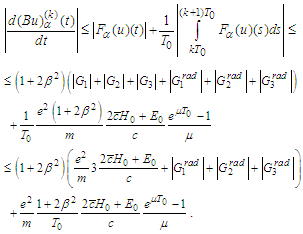 But
But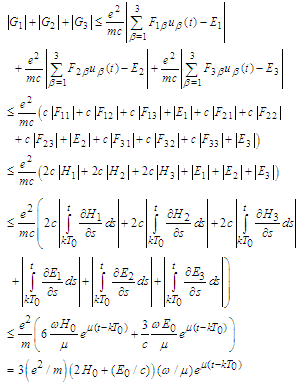 and consequently
and consequently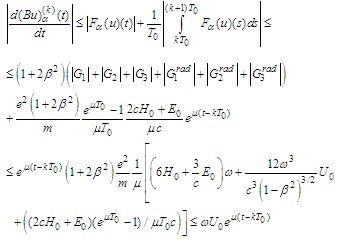 and so on. Therefore
and so on. Therefore  .Remark 2. In order to obtain suitable estimations for higher derivatives we use the chain of inequalities
.Remark 2. In order to obtain suitable estimations for higher derivatives we use the chain of inequalities  In this way we compensate the degree of
In this way we compensate the degree of  in the nominator by the degree of
in the nominator by the degree of  in the denominator.In what follows we show that B is contractive operator.First we notice that the following Lipschitz estimate for the expression
in the denominator.In what follows we show that B is contractive operator.First we notice that the following Lipschitz estimate for the expression is valid:
is valid:  and in a similar way from
and in a similar way from  we obtain
we obtain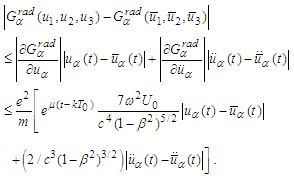 Then
Then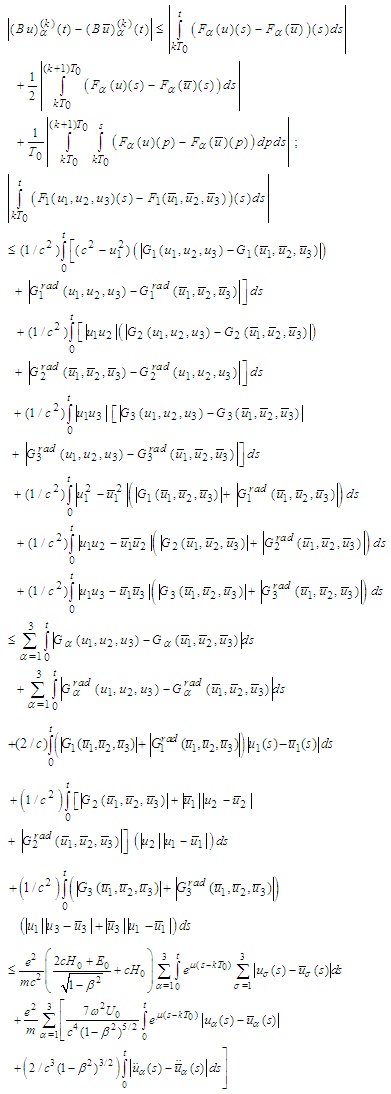


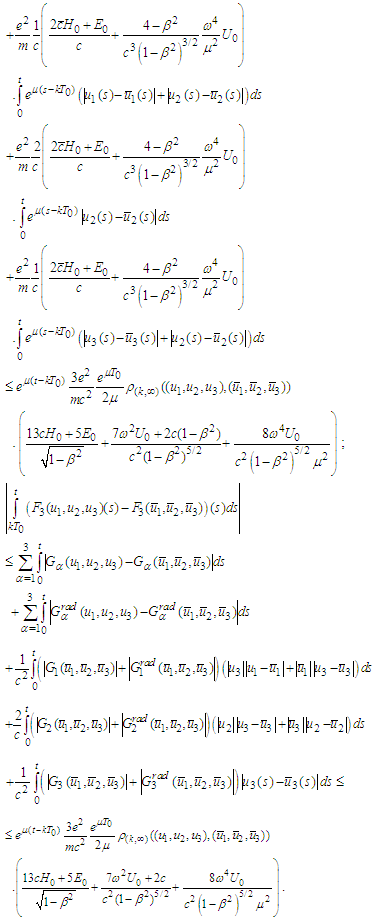 For the second term we obtain
For the second term we obtain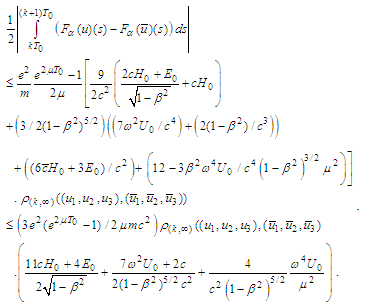 For the third term we get
For the third term we get Therefore
Therefore 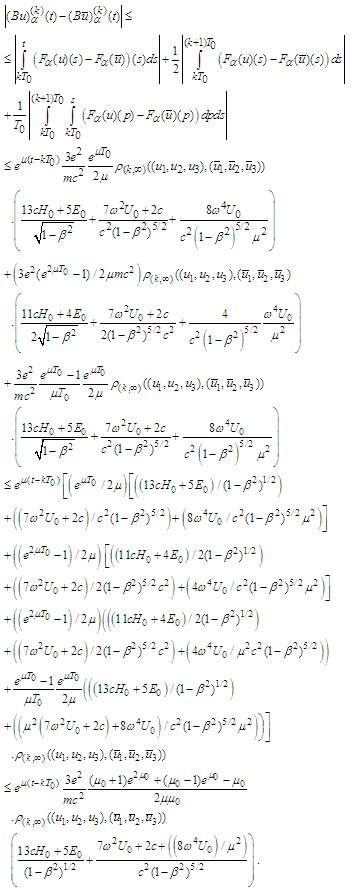 Consequently
Consequently In what follows we make the same estimates for the derivatives of the operator functions B (for higher derivatives we recall Remark1). Indeed,
In what follows we make the same estimates for the derivatives of the operator functions B (for higher derivatives we recall Remark1). Indeed, and
and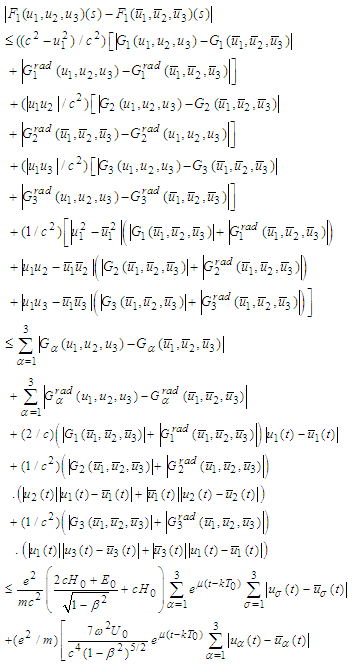
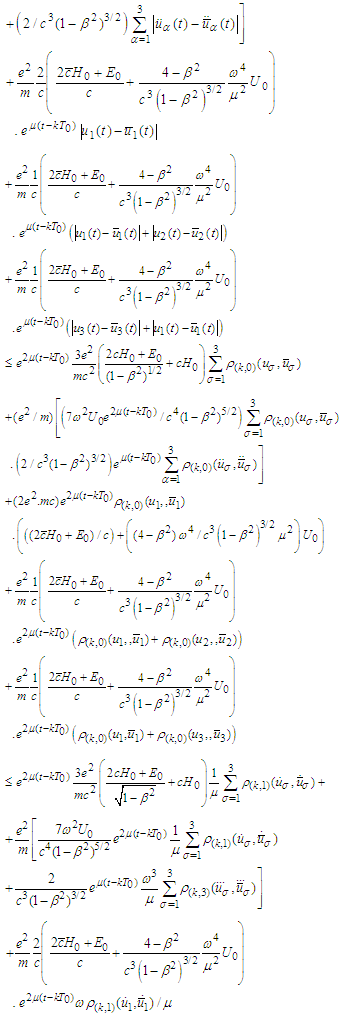
 Therefore the operator B is contractive in the sense of [35]. Its fixed point in view of the Main lemma is a
Therefore the operator B is contractive in the sense of [35]. Its fixed point in view of the Main lemma is a  periodic solution of (6).Theorem 1 is thus proved.
periodic solution of (6).Theorem 1 is thus proved.6. Conclusions
- As an immediate consequence we obtain an existence-uniqueness of periodic solution for betatron equation (cf. [14], [27], [38[-[41]). Specific applications we will give in next papers.
 Abstract
Abstract Reference
Reference Full-Text PDF
Full-Text PDF Full-text HTML
Full-text HTML